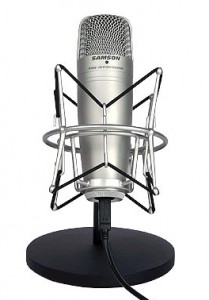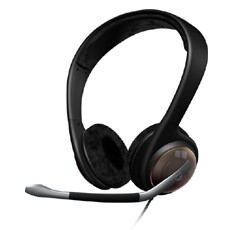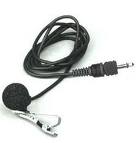Choosing The Right Microphone – Part Two
So – What Microphone Do I Need?
I guess after reading ‘Choosing The Right Microphone – Part One‘ you are still wondering….’what microphone do I need?‘ – A headset, like one you’d use for Skype calls? – A lapel or tie-clip mic? – A large diaphragm ‘studio’ condensermic? You’ll need different mics for different jobs, and below you’ll find an overview of what you need to know to make a more informed decision.
My Microphone Choice
I use a Sennheiser PC155 headset with mini-jack connectors (around $99) on a standard laptop pc with no special soundcard for all ausio and ‘off-camera’ video recording. Sennheiser have been making quality microphones for over 70 years and are used by top level studio and stage professionals worldwide. This is why they know how to make a good product and why their headsets sound great. Everyone says that my audio sounds great and that is all the feedback I need. There are various things I can do to process the sound and make it richer and warmer (noise reduction, compression, equalisation – in that order) but I don’t need to – it sounds great just as it is. Just record, edit and release the product.
Computer Audio
Now it is true that ‘ordinary’ computers and laptops have low quality sound components (Macs have reasonably good audio compnents built in) and that often this can lead to low sound quality recording and playback. However, if you choose a good quality headset with a USB option (most Sennheiser headsets come with a USB adaptor) this will feed a good quality digital signal direct into your computer and result in ‘good’ to ‘great’ sound quality for a simple, easy to use, ‘plug in and record’ portable recording set up. To help you decide what is best for you and your recording needs and preferences, here are the…
Pro’s & Cons 3 Common Microphone Types
Microphones that you would use for audio products, video shoots and online voice calls.
A headset, like one you’d use for Skype calls (see above)
Pros
- The microphone is a close and consistent distance from your mouth, which means instant consistent sound levels and intimate voice recording
- Low cost and easy to look after
- Convenient to use, store and travel with
- Multi-use: audio recording, skype calls, video voice over…
Cons
- Low cost or cheap brand units (mini-jack or USB) can sound thin and noisy
- Closeness to mouth sometimes records ‘sticky mouth’ sounds! (HOT TIP! Can be alleviated by eating slices of green apple…)
- It doesn’t look great on camera! So get a lapel mic. too…
Lapel or tie-clip mic
Pros
- clips to clothing at mid chest to collar bone height so not obvious in video shot
- recommended for indoor video shoots only
- connects direct to camera audio input socket
- if mic is not centred or is too low, can give inconsistent recording levels
- side to side head movement or looking up while speaking changes recording levels
- low recording level will usually include background noise and hiss which had to be removed in the editing process
- many take a battery, so check you have power before recording, and you switch off afterwards
- outdoor use will usually record wind noise which is troublesome and not easy to remove (a foam ‘wind shield’ on the mic. can help)
Large diaphragm ‘studio’ condenser mic (USB)
Low cost ‘studio’ condenser mics such as the Samson C-01, Blue Snowball and Rode Podcaster are consumer mics built to a price for the podcasting and home recording market (and so provide good quality audio but not really ‘studio’ quality – this involves more than just a mic.). These mics bring good quality ‘studio’ voice recording at an affordable price, but for ‘studio’ quality sound there are other factors to consider beyond than just plugging in and recording (which is all you need to do at base level).

Samson CO1U (USB Condenser Microphone)
Pros
- crisp, warm and authentic reproduction of your voice
- use close to mouth (8-10 inches) for intimate sound
- using a ‘pop’ shield reduces ‘popping’ the sound of your natural voice ‘plosives’ (hold the palm of your hand close to your mouth and say ‘pepperoni pizza’ and feel the blast of air on your skin – this sounds like a hurricane on a condenser mic!)
- use for audio recording, video voice over – can look good on camera
Cons
- condenser mics need looking after well
- highly sensitive to knocks, humidity & damage
- the very lightweight and sensitive diaphragm can collect dust over time which reduces response and therefore audio quality
- must be used in a VERY quiet environment as they will pick up ALL background sound
- mic and stand can be cumbersome to set up
- not compact (mic, stand and pop shield) and they don’t travel well
Summary:
By all means, use a USB condenser mic to give you that edge of crispness, warmth and greater accuracy in voice recording, but consider whether you really need that within the context of all the above – it is not essential to use a condenser mic to get a great sounding audio product. When recording professional audio I stayed well away from the philosophy of ‘it’s good enough for rock and roll’. However, when it comes to home recording for audio products, getting a ‘good enough’ sound with easy to use, convenient equipment makes life simpler and allows you to focus on content and delivery. Read Choosing The Right Microphone – Part One‘
* * * * * * * * * * * * * * * * * * * * * * * * * * * * * * * * *


